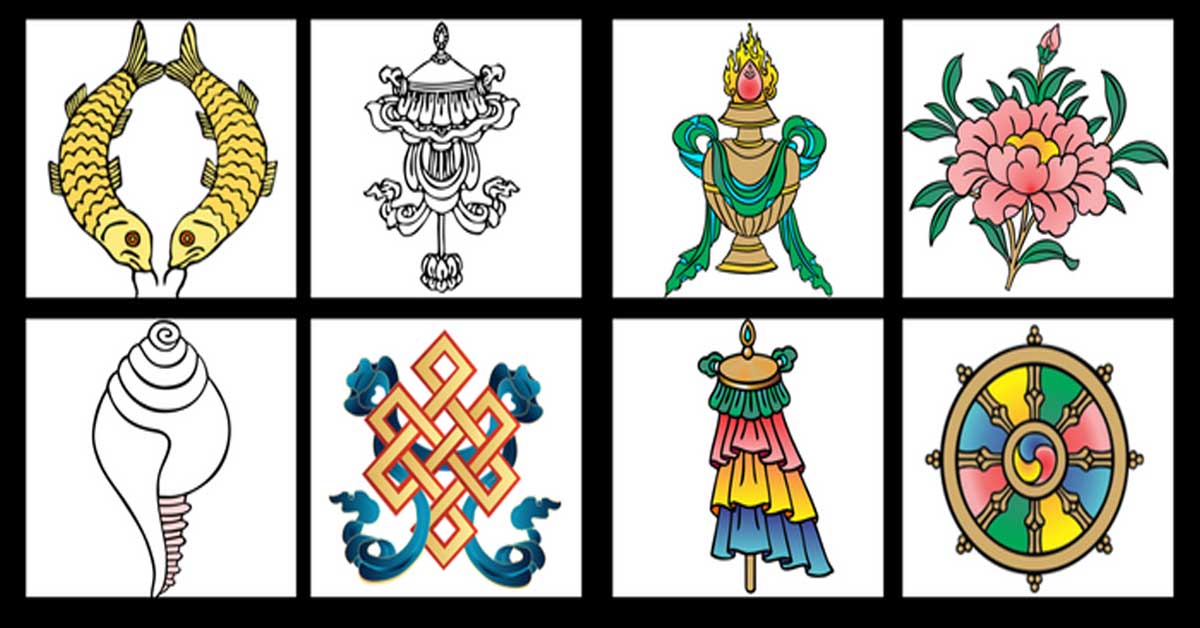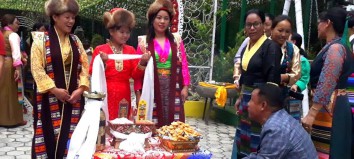Ashtamangala

The eight symbols for luck are widespread within the Tibetan cultural area. The eight symbols of well fortune are often found in practically every Tibetan ceremony and are offered as offerings. Often they not only decorate religious buildings and personal houses, but also can be found as ornaments on items of clothing and thangkas. Their symbol content is explained somewhat differently.
Shell:

The shell has a clockwise housing and symbolizes the deep, far reaching and melodic sound of the Dharma teachings. The teachings harmonize with the predispositions, desires and possibilities of beings. The sound of Dharma awakens you from the deep sleep of ignorance. In the monastery, the monks are usually called to meetings by the sound of the Muschenlhorn.
Precious umbrella

The umbrella stands for salvation activities to protect living beings from obstacles, harmful influences, diseases, demons etc. In addition, it fends off all types of temporary and permanent suffering from the various samsaric areas in future livelihoods. In addition, the umbrella represents the cooling shadow that shields from the heat of the mental plagues. As a traditional status symbol, it also shows the sovereignty of the Buddha as world ruler. Often there is a precious umbrella 13 layers, which stand for the great deeds of the Buddha and in the other context also for the Bodhisattva levels.
Victory banner

The victory banner symbolizes the complete victory of Buddhist teaching over all harmful, unwholesome and confusing forces. On the personal level, the banner represents the victory of the three gates of body, speech and mind over their negative aspects and obstacles. and more specifically, this banner shows the victory of knowledge over all forms of ignorance.
Two golden fish

The two fish symbolize the happy state of fearlessness. They show the possibility of saving oneself from drowning in the ocean of suffering and of moving freely and spontaneously from place to place, just like fish swimming through the water. In Hinduism, the two fish were originally a symbol for two sacred rivers, the Ganges and Yamuna. At the level of the tantric secret teachings, they symbolize the so-called sun, and moon Nadi, in which prana flows. They also stand for the union of the female and the male.
Wheel of teaching

The precious wheel is a symbol for Buddhist teaching with the three high training courses:
The ethical discipline forms the hub,
The razor-sharp spokes, which like Manjushri’s sword of wisdom cut through ignorance and thus the root of the life cycle, represent wisdom,
The concentrative collection protects from distractions and grants like the rim of the Wheel stability.
In most representations, the wheel of teaching has eight spokes, symbols of the eightfold noble path to liberation. In the symbol, this lucky sign corresponds to the wheel of a chariot used to defeat the enemy. Because the unity of ethics, concentration and wisdom are the “weapons” with which the actual opponents, one’s own deluded actions and mental troubles are defeated.
However, this symbol also represents the “turning of the wheel of teaching”, because according to the Mahayana conception, the Buddha offered three cycles or “wheels” of teaching after his enlightenment. like a rolling wheel, the sublime spread the liberating Dharma and thus brought about realizations among his students.
Endless knot

The knot is a popular ornament that represents the teaching of the dependent (the actual existence of all phenomena) and its compatibility with emptiness. At the same time, this lucky sign also expresses the limitless knowledge of the enlightened and the unity of wisdom and compassion.
The knot also indicates that not a single phenomenon exists independently of the other phenomena. in its closed balance, the infinite knot also symbolizes harmony in general, favorable circumstances and, in addition, in its endlessness often a long life.
Lotus flower

Although the lotus plant thrives in the mud and brackish water, its bloom is so pure and sublime that no dirt adheres to it. The open lotus therefore represents the complete purity of body, speech and mind. It also symbolizes the blossoming of all healing actions and powers during the blissful enlightenment. In secret Buddhism, the lotus is also used as a symbol for a divine birth and for the female secret organ and for the subtle energetic centers (chakra).
Treasure vase:

The lavishly filled vase full of treasures stands for an unstoppable flow of good sand, long life, beneficial circumstances and all the treasures of the world, including the wealth of liberation. It is characteristic of this treasure vase that it never gets empty. It can therefore also be found in the context of wealth gods such as Vaishravana and Vasudhara. There are many rituals in Tibetan Buddhism that use treasure vases.









